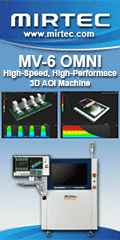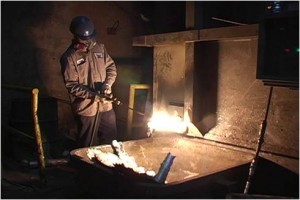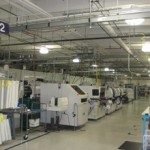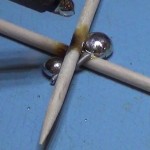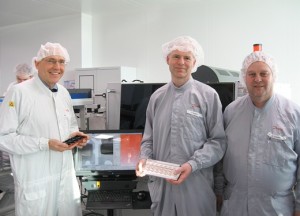
Virtual Industries’ Owners Daren Palmer (left) and Tom Mealey (right) provide manual vacuum handling solutions to companies across the globe. This year, 2017, marks Virtual Industries Inc.’s 30th year in business.
Founded in 1987, Virtual Industries Inc. is headquartered in Colorado Springs, CO by Owners Tom Mealey and Daren Palmer. For 30 years, Virtual Industries has been a leading supplier of manual vacuum handling solutions to the world’s high-technology firms. The company’s patented ESD-safe products are used by Class I clean room personnel, electronic assemblers, semiconductor manufacturers, universities and scientists on a global basis. Mealey and Palmer’s success has come from developing innovative manual vacuum handling tools and pick-up tips based on customer requests and customer feedback. These tools provide customer-specific solutions that make assembly and processing operations more productive and ergonomic.
Virtual Industries began selling its products in the United States in 1988, and established international operations in 1989. The company has agents and distributors in more than 60 countries and serves customers in nearly 200 countries. More than a third of Virtual Industries’ sales come from outside the United States.
The company’s product line features hand tools that replace mechanical tweezers or other gripping means for many applications. Many of these tools are portable and eliminate the need for vacuum hoses or power cords. This makes these tools ideally suited for ergonomic manipulation of parts during assembly, inspection, rework and service operations. In addition to hand tools, Virtual Industries offers a broad line of accessories including miniature rubber vacuum cups, wafer handling tips and precision machined tips for critical handling operations.
For customers who do not require portability, there is a selection of bench top systems that are powered by line voltage, compressed air, or in-house vacuum sources. These tools use a vacuum pen that is tethered with a small diameter vacuum or air pressure line. Parts ranging in size from 0.100 microns (0.004″) to 300 mm (12 inches) can be handled easily.
Recently, the company introduced two new products: the TWEEZER-VAC® Elite (TV-1500-ELITE) and ADJUST-A-VAC® ESD Safe Kit. Each was developed in response to customer concerns: The TWEEZER-VAC Elite firmly grasps critical components and shows the vacuum level via a 10-segment bar graph display. The ADJUST-A-VAC ESD Safe Kit with ESD-safe Delrin Small Parts Tip and ESD-safe rubber Vacuum Tips (AV-6000-SP8-BD-220) manually handles thin/delicate substrates, wafers, MEMS devices and other very fragile components. This vacuum-tweezer allows the operator to adjust the vacuum level from just below atmospheric pressure to up to 10″ of mercury depending on the fragility of the part being handled. Both products feature an integrated 10 segment bar-graph-display that visibly shows the vacuum level present during handling operations, and the vacuum ports on each integrate a user-replaceable inlet filter that protects operation of the tool from dust particles. Both systems are available in various sets depending on individual handling applications, and in either 110 or 220 V operation.
All of the company’s tools and technologies are designed to solve the smallest of handling challenges. “Handling of miniature parts is becoming more challenging for manufacturers as everything we use in our daily lives becomes either smaller itself or more complex functions are added,” said Mealey. For example, companies are developing high-tech glasses that can record every waking moment. Cell phones continue to include more gadgets that integrate into our daily lives. Pacemakers, hearing aids, and hearing implants are becoming smaller yet provide improved quality of life for many across the globe.”
Mealey added that for many of the components inside of these gadgets, there is automated equipment that can place parts as small as a 01005 resistor with incredible accuracy and speed. However, there are parts that must be hand assembled either because of their odd shape or sensitive surface. While many parts can be manipulated easily with an old-fashioned mechanical tweezer, the downside is that mechanical tweezers have high cost associated with them. For example, if an assembly person drops the tool, the delicate tip profile is easily damaged and the costly tweezer must be scrapped.
Palmer added, “Many of our tools that are available today can be used for assembly of a wide variety of miniature or odd-sized parts without the need for tip customization. The Vacuum-Tweezer tool is well-suited for many of these applications. Everybody knows what a tweezer is and that a vacuum picks stuff up.” Unlike a mechanical tweezer that has two gripping surfaces, the vacuum tweezer has a handle with a control button and only a single conical point at the tip. The tip has an orifice opening that is connected to a vacuum source. The vacuum source creates a constant flow of low pressure that is used to grip anything that comes into contact with the tip.
There are several advantages to using a tool that has only a single gripping tip. First, there is no mechanical squeezing of the gripped part that could cause breakage or other mechanical damage to a fragile item. Secondly, once a part is gripped by the vacuum at the tip, it stays on the tip and is released only when placed and the release control button on the vacuum tweezer handle is pressed. Mealey said, “Everyone who has used mechanical tweezers to pick-and-place small parts is familiar with the “zing effect”: you pick a part, it slides off one of the tweezer tips and it zings across the room, never to be seen again.” Small parts can be very expensive so lost parts can add significantly to the assembly process cost. Finally, with a vacuum tweezer, users can grip a part from the side, from the top or from any other protruding feature; two opposing flat surfaces are not required to grip the part.
All of Virtual Industries’ products are bench top or smaller, but that doesn’t mean that they don’t provide large benefits. They are versatile, reliable and cost-effective. They are easy-to-use and help solve customers’ handling challenges. Implementation of vacuum tweezers for assembly of electrical or mechanical parts is limited only by the imagination of the engineer.
For more information about Virtual Industries Inc., contact the company at 2130 Victor Place, Colorado Springs, CO 80915; 719-572-5566; E-mail: ; Web site: www.virtual-ii.com.
Views
Skyscraper 1
